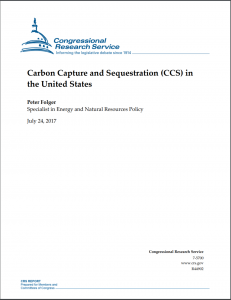Full Title: Carbon Capture and Sequestration (CCS) in the United States
Author(s): Peter Folger
Publisher(s): Congressional Research Service
Publication Date: July 1, 2017
Full Text: Download Resource
Description (excerpt):
Carbon capture and sequestration (or storage)—known as CCS—is a process that involves capturing man-made carbon dioxide (CO2) at its source and storing it permanently underground. (CCS is sometimes referred to as CCUS—carbon capture, utilization, and storage.) CCS could reduce the amount of CO2—an important greenhouse gas—emitted to the atmosphere from the burning of fossil fuels at power plants and other large industrial facilities.
Globally, two fossil-fueled power plants currently generate electricity and capture CO2 in large quantities: the Boundary Dam plant in Canada and the Petra Nova plant in Texas. Both plants retrofitted post-combustion capture technology to units of existing plants. A third fossil-fueled electricity-generating operation, the Kemper County Energy Facility in Mississippi, was scheduled to begin CCS operations by now, but cost overruns and delays in construction and operations led to the suspension of the plant’s CCS component on June 28, 2017.
Each of the power plants using CCS systems may be referred to as a demonstration project, or a nearly first-of-its-kind venture using technologies developed at a pilot scale ramped up to commercial scale. Such projects move through many phases, from the initial research and development (R&D) phase through the final commercial deployment phase. It is not unusual for projects in the demonstration phase of this process to experience higher-than-anticipated costs, delays, and other challenges. Several other U.S. Department of Energy (DOE)-supported demonstration projects, such as FutureGen, the AEP Mountaineer project, and the Hydrogen Energy California Project, among others, faced challenges that led to their cancellation or suspension. Given the mixed success of large CCS projects in the United States, the economic viability of, and the commercial interest in, such projects remains uncertain.
The U.S. Department of Energy has long supported R&D on CCS within its Fossil Energy Research and Development (FER&D) portfolio. The Trump Administration proposed to cut FER&D funding substantially in its FY2018 budget request. The Trump Administration’s proposal differs from the policy trends of the previous two Administrations, which supported R&D on CCS and emphasized the development of large-scale demonstration projects to evaluate how CCS might be deployed commercially. Some in Congress have signaled continued support for DOE’s R&D efforts with respect to CCS. The House Energy and Water Development appropriations draft legislation would support CCS R&D at a level comparable to that in FY2017, for example. In addition, some Members of Congress have continued to introduce legislation in the 115th Congress intended to advance CCS. These bills include H.R. 2010, H.R. 2011, H.R. 2296, S. 843, S. 1068, and S. 1535.
The Obama Administration commissioned a CCS task force, which concluded in 2010 that the largest barrier to long-term demonstration and deployment of CCS technology is the absence of a federal policy to reduce greenhouse gas emissions. The task force further concluded that widespread deployment of CCS would occur only if the technology is commercially available at economically competitive prices. None of those factors appear to be in place currently, which may indicate that demonstration and deployment of industrial-scale CCS will be delayed compared to earlier projections, pending future policy, technological, and economic developments.
